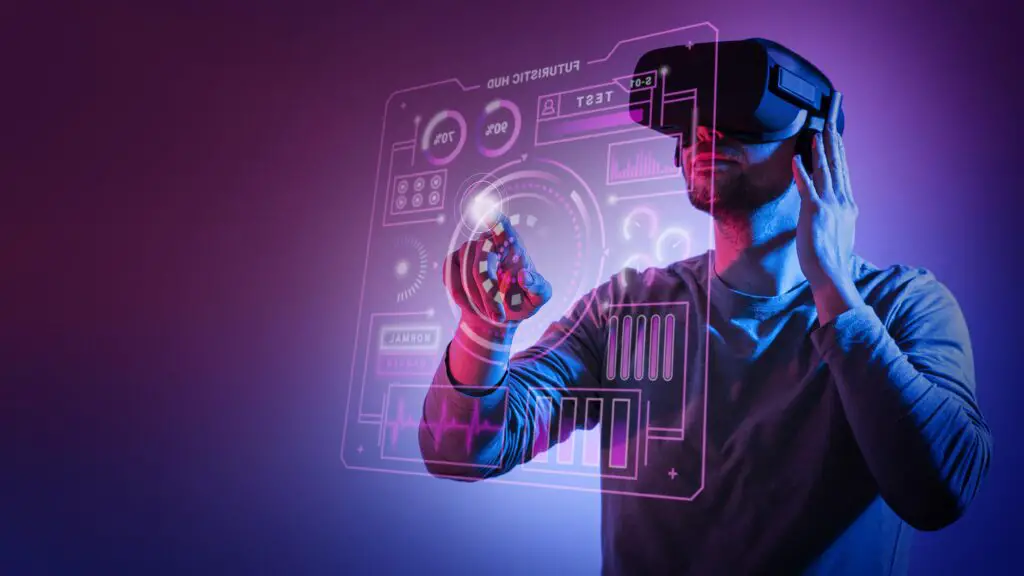Introduction to Augmented Reality
Augmented reality (AR) is a technology that blends virtual elements with the real world, providing users with an enhanced and interactive experience. It overlays computer-generated images, videos, or information onto the real-world environment, allowing users to interact with digital content in real time. Unlike virtual reality (VR), which creates a completely immersive digital environment, AR supplements the real world with virtual objects, enhancing the user’s perception and interaction.
How Augmented Reality Works
Augmented reality works by utilizing a combination of hardware and software components. It typically involves a display device, such as a smartphone, tablet, or wearable headset, equipped with sensors, cameras, and processing capabilities. These devices capture the user’s real-world environment and track their movements in order to overlay virtual content accurately.
Using computer vision algorithms and object recognition techniques, AR systems identify and analyze the physical environment. They then superimpose digital content onto specific objects or locations in real time. This process requires precise tracking and mapping of the user’s surroundings, ensuring that virtual elements align seamlessly with the real world.
Applications of Augmented Reality
AR in Gaming and Entertainment
Augmented reality has revolutionized the gaming and entertainment industry by introducing interactive and immersive experiences. Popular games like Pokemon Go have demonstrated the potential of AR in blending the virtual and real world. Players can explore their surroundings, discover virtual creatures, and engage in battles within their physical environment.
AR in Education and Training
In the field of education, augmented reality has opened up new opportunities for interactive learning. It enables students to visualize complex concepts, such as scientific models or historical artifacts, in a three-dimensional space. AR applications can also provide interactive tutorials, simulations, and virtual experiments, enhancing the learning experience and making it more engaging.
AR in Healthcare
Augmented reality has found applications in healthcare, ranging from surgical training to patient care. Surgeons can use AR to overlay medical imaging data onto a patient’s body during procedures, improving precision and reducing risks. AR can also assist in medical education by providing interactive anatomy lessons or virtual simulations of complex medical procedures.
AR in Retail and E-commerce
In the retail and e-commerce industry, augmented reality has transformed the way customers shop and interact with products. Virtual try-on features allow customers to see how clothing or accessories would look on them without physically trying them on. AR also enables customers to visualize furniture or other items in their own space before making a purchase. These interactive experiences enhance customer engagement and improve the overall shopping experience.
AR in Architecture and Design
Augmented reality is revolutionizing the architecture and design fields by allowing professionals to visualize and present their ideas in a more immersive and interactive way. Architects can use AR to overlay digital models onto real-world environments, enabling clients to experience the proposed designs in a realistic manner. Interior designers can also use AR to showcase different furniture or decor options within a space, helping clients make informed decisions.
AR in Manufacturing and Engineering
In manufacturing and engineering, augmented reality is used for tasks such as assembly, maintenance, and quality control. AR overlays digital instructions or annotations onto physical objects, guiding workers through complex processes. This improves efficiency, reduces errors, and enhances productivity in industrial settings.
Benefits of Augmented Reality
Enhanced User Experience
AR provides users with immersive and interactive experiences, enhancing their engagement and satisfaction. By overlaying virtual elements onto the real world, AR creates a sense of wonder and excitement, making interactions with digital content more memorable.
Improved Learning and Training
Augmented reality has proven to be a valuable tool for learning and training. By visualizing complex concepts and providing interactive simulations, AR enhances understanding and retention of information. It allows for hands-on learning experiences in a safe and controlled environment.
Increased Efficiency and Productivity
AR can streamline various processes and improve efficiency in industries such as manufacturing, logistics, and maintenance. By providing real-time instructions and guidance, AR reduces the need for extensive training and minimizes errors. Workers can access relevant information and data directly within their field of view, eliminating the need to consult manuals or reference materials.
Enhanced Visualization and Design
Augmented reality enables users to visualize designs, prototypes, and architectural plans in a realistic and interactive way. This enhances the design and decision-making process by allowing stakeholders to experience and evaluate concepts before they are implemented. AR also enables designers to iterate and make adjustments quickly, saving time and resources.
Increased Customer Engagement
AR experiences captivate and engage customers, leading to increased brand loyalty and customer satisfaction. By offering interactive and immersive elements, businesses can create unique and memorable experiences that differentiate their products or services. AR-powered marketing campaigns and applications attract attention, generate buzz, and encourage social sharing, expanding brand reach and awareness.
Challenges and Limitations of Augmented Reality
Technical Limitations
Augmented reality technology is still evolving, and there are technical limitations that need to be addressed. Challenges include accurate tracking and mapping of the real-world environment, ensuring seamless integration of virtual content, and optimizing performance across different devices and platforms. Improvements in hardware, software, and connectivity are necessary to overcome these limitations fully.
Cost and Accessibility
Implementing AR systems can be costly, especially for small businesses or organizations with limited resources. The development of AR applications, the purchase of compatible devices, and the maintenance of infrastructure require significant investments. Additionally, accessibility is a concern as not all users may have access to AR-enabled devices or reliable internet connections.
Privacy and Security Concerns
AR technology raises privacy and security concerns, as it involves capturing and analyzing real-time data about users’ surroundings and actions. Safeguarding personal information and ensuring data protection are crucial considerations. Users must have control over the data collected and be informed about how it will be used to maintain trust and compliance with privacy regulations.
Ethical Considerations
The use of augmented reality raises ethical considerations related to user consent, data usage, and potential societal impacts. Clear guidelines and ethical frameworks need to be established to address issues such as the manipulation of virtual content, the influence of AR on user behavior, and potential addiction or dependency on AR experiences.
Future Trends in Augmented Reality
Integration with Artificial Intelligence
The integration of augmented reality with artificial intelligence (AI) will unlock new possibilities and enhance user experiences. AI algorithms can analyze user preferences, behavior, and environmental data to provide personalized and context-aware AR content. This combination will enable more intelligent and adaptive AR applications.
AR in Wearable Devices
The development of wearable devices, such as smart glasses or contact lenses, holds great potential for augmented reality. These devices can provide hands-free AR experiences, seamlessly integrating digital content into users’ field of view. As wearable technology advances, it will likely lead to more widespread adoption and integration of AR into various industries.
Augmented Reality in Social Media
Social media platforms are embracing augmented reality to enhance user engagement and interaction. AR filters and effects allow users to overlay virtual elements on their photos and videos, adding a creative and entertaining aspect to their social media presence. This trend is expected to continue, with social media platforms integrating more AR features and providing tools for content creation.
AR in the Automotive Industry
The automotive industry is exploring augmented reality for various applications, including heads-up displays (HUDs), driver assistance systems, and interactive in-car experiences. AR HUDs provide real-time information, such as navigation directions or vehicle status, directly in the driver’s line of sight. AR can also enhance the driving experience by overlaying virtual objects or information onto the real-world environment.
Conclusion
In conclusion, augmented reality has revolutionized various industries by providing enhanced user experiences, improved learning and training, increased efficiency and productivity, and increased customer engagement. From gaming and entertainment to healthcare, retail, architecture, and manufacturing, AR has transformed the way we interact with digital content and the real world. Despite challenges such as technical limitations, cost considerations, privacy concerns, and ethical considerations, the ongoing advancements in technology and increasing adoption of AR will continue to drive its growth. As AR integrates with AI, expands into wearable devices, and influences social media and automotive industries, it bridges the gap between the physical and digital realms, shaping the future of human-computer interaction.
FAQs
Q: What is the difference between augmented reality and virtual reality?
A: Augmented reality overlays virtual elements onto the real world, enhancing the user’s perception of reality. Virtual reality, on the other hand, creates a completely simulated environment that users can immerse themselves in.
Q: Can augmented reality be used for military applications?
A: Yes, augmented reality has various military applications, including training simulations, situational awareness, and heads-up displays for soldiers.
Q: Are there any health risks associated with using augmented reality?
A: When used responsibly and in moderation, augmented reality poses minimal health risks. However, prolonged use of AR devices or experiences that cause motion sickness can potentially lead to discomfort.
Q: How is augmented reality changing the retail industry?
A: Augmented reality is transforming the retail industry by offering virtual try-on experiences, enhanced product visualization, interactive advertising, and personalized recommendations. These features enhance the overall shopping experience and increase customer engagement.
Q: What are some popular augmented reality apps?
A: Some popular augmented reality apps include Pokemon Go, Snapchat, IKEA Place, and Google Maps’ AR navigation.








I couldn’t refrain from commenting. Well written!
Thank You 🙂